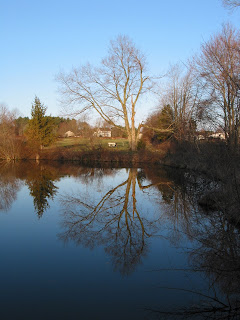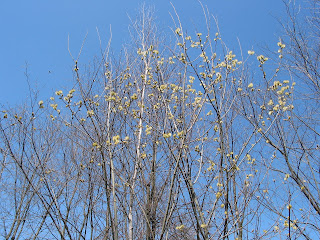 The trunks, as is typical, are forked and crooked. The crowns are broad and spreading; the ashy gray bark is deeply furrowed.
The trunks, as is typical, are forked and crooked. The crowns are broad and spreading; the ashy gray bark is deeply furrowed. The trees all seem healthy, although I did notice some black coloration at the base of one. I am not sure if this is butternut canker. I hope not.
The trees all seem healthy, although I did notice some black coloration at the base of one. I am not sure if this is butternut canker. I hope not. The canker was introduced into the U.S. around 1960, probably coming in on shipments from Asia through the St. Lawrence seaway. Apparently over 90% of butternuts across the tree's range are infected; the trees that become infected die within 15 years.
The canker was introduced into the U.S. around 1960, probably coming in on shipments from Asia through the St. Lawrence seaway. Apparently over 90% of butternuts across the tree's range are infected; the trees that become infected die within 15 years.So far, ours look healthy. During the last few weeks I have watched the buds emerge and expand, the catkins (hosting the stamens) elongating further with each passing hot day. The two photos below are from the same branch; one taken on April 18th, the other, 9 days later, on April 27th.

 The red and gray squirrels love these butternuts. Even in spring they carry off partly chewed nuts that lie beneath the tree.
The red and gray squirrels love these butternuts. Even in spring they carry off partly chewed nuts that lie beneath the tree. The large fruits form in the fall -- the hard, ribbed nut (above) is contained within a yellow-green, sticky husk. Once they fall to the ground the husks turns dark black. Ambitious folks gather the sticky mess (they stain your hands) and extract the sweet, buttery-flavored nut. I recall that we had some stashed in our attic many years ago. I don't remember if we put them there for later harvest or if squirrels brought them in (since our house has always been squirrel porous).
The large fruits form in the fall -- the hard, ribbed nut (above) is contained within a yellow-green, sticky husk. Once they fall to the ground the husks turns dark black. Ambitious folks gather the sticky mess (they stain your hands) and extract the sweet, buttery-flavored nut. I recall that we had some stashed in our attic many years ago. I don't remember if we put them there for later harvest or if squirrels brought them in (since our house has always been squirrel porous).We look out the back door to the two biggest butternuts. I hope these "white walnuts" live many more years.

















































